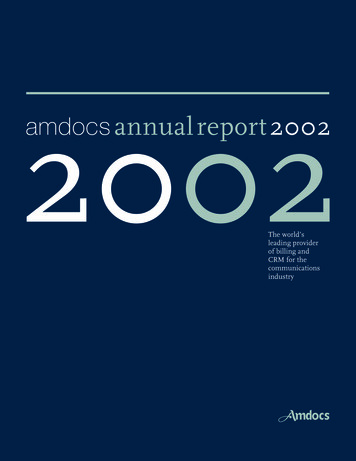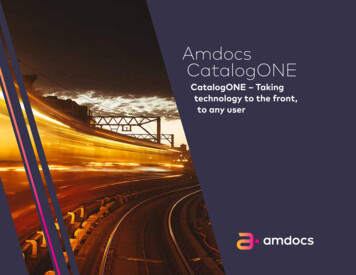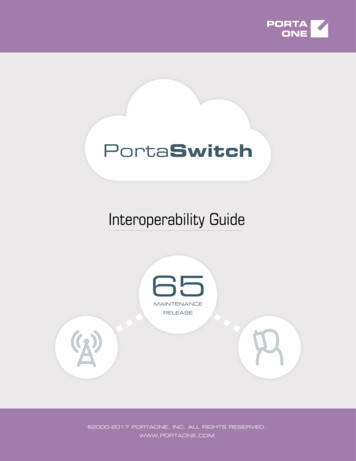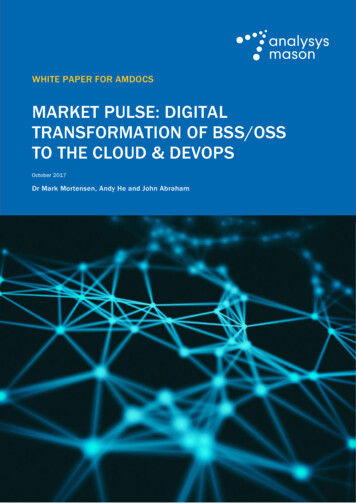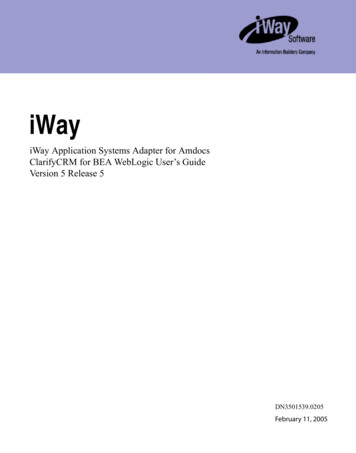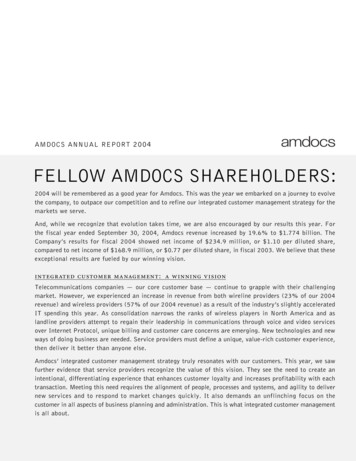
Transcription
Solution ProfileSeptember 2021AmdocsMicroservices360Author: Francis Haysom – Principal Analyst, BSS/OSS Strategywww.appledoreresearch.com
Amdocs Microservices360 - Solution ProfilePublished by Appledore Research LLC 44 Summer Street Dover, NH. 03820Tel: 1 603 969 2125 Email: info@appledorerg.com www.appledoreresearch.com Appledore Research LLC 2021. All rights reserved. No part of this publication may be reproduced,stored in a retrieval system or transmitted in any form or by any means – electronic, mechanical,photocopying, recording or otherwise – without the prior written permission of the publisher.Figures and projections contained in this report are based on publicly available information onlyand are produced by the Research Division of Appledore Research LLC independently of any clientspecific work within Appledore Research LLC. The opinions expressed are those of the statedauthors only.Appledore Research LLC recognizes that many terms appearing in this report are proprietary; allsuch trademarks are acknowledged, and every effort has been made to indicate them by the normalUSA publishing standards. However, the presence of a term, in whatever form, does not affect itslegal status as a trademark.Appledore Research LLC maintains that all reasonable care and skill have been used in thecompilation of this publication. However, Appledore Research LLC shall not be under any liability forloss or damage (including consequential loss) whatsoever or howsoever arising because of the useof this publication by the customer, his servants, agents or any third party.Publish date: 9/6/2021Cover image by Francis HaysomPage 2www.appledoreresearch.com Appledore Research 2021
Amdocs Microservices360 - Solution ProfileEXECUTIVE SUMMARYAmdocs is a provider of customer experience software solutions and services to communications,entertainment, and media service providers. Amdocs solutions include BSS, OSS, Media &Entertainment, Digital User Experience, network control, optimization, and network functionvirtualization.Microservices360 (MS360) was originally developed as the core platform to support Amdocs CES20cloud-native suite. MS360 supports the development of CES20, an umbrella modular suite thatincludes all Amdocs BSS products, solutions, and services. Microservices360 has enabled themodernization of the digital experience DigitalONE, the catalog products CatalogONE, as well as thecharging/billing products RevenueONE. CES20 is now a proven modular, open and integratedbusiness solution, backed by cloud-native and microservices technology, in contrast to its previouspositioning as a set of monolithic applications.From its internal experience, Amdocs recognized that the value of Microservices360 was much morethan tools and platform. It provided a methodology to enable CSPs to adopt microservicesarchitecture and CI/CD deployment. Helping CSPs to become digital software companies.CSPs have been trying to become software companies for some time, trialing many open-sourcetools and using in-house agile delivery. However, the success of these approaches has often beenlimited. CI/CD development often remains more a "science project" within CSPs. Traditional deliveryand development practice remain in place, with low levels of innovation and slow yearly andquarterly releases continuing to be the norm.Using MS360 Amdocs has put itself in a powerful position to help CSPs migrate from their traditionaldevelopment and deployment approaches to one that is cloud-native and agile. As an existingsupplier to CSPs they can enable existing and new customers to bridge the gap between the currentmonolithic approaches toward cloud-native approaches. It also supports new types of customerengagement and services, ones built on trust and partnership.Amdocs is increasingly seeing demand for this approach from customers. An approach based onchoosing a long-term collaborative partner that can codevelop, and deliver, what is needed ratherthan a vendor with a set of pre-defined features. Amdocs is seeking to enable customer choices,including the re-use of existing legacy system investment. They are aiming to replace the traditionalcumbersome waterfall procurement of telcos with a new dynamic supply chain.This changed approach will be an important foundation for telcos in their ability to innovate andmonetize their services to others as a platform, covered in Appledore’s recent report, Disaggregationfor Growth - Telco as a Platform. Appledore Research 2021www.appledoreresearch.comPage 3
Amdocs Microservices360 - Solution ProfileMICROSERVICES360As the name indicates Microservices360 has been developed to enable ubiquitous use ofmicroservices within Amdocs. It also aims to allow Amdocs to embrace opensource practices andcreate a strong framework for product innovation. Microservices360 provides a unified platform formicroservices development across the company and with customers. Microservices360 isresponsible for managing the operability aspects of the microservices (such as monitoring, security,logging) - so developers can focus on writing functional services which can run on anyinfrastructure. The Amdocs Microservices360 development platform and methodology has beenrolled out to thousands of Amdocs developers worldwide.ProgramAmdocs see microservices as being about software design principles, rather than necessarily servicesize. In developing Microservices360 they have worked with cloud native expert consultants andpioneering companies, such as Contino and Thoughtworks (a leading visionary consultancy forMicroservices), but also RedHat, IBM, and even AWS.Microservices360 has evolved:1. Firstly, as a program within the company2. Then becoming a robust platform, allowing development of Amdocs BSS applications.3. Finally, becoming a framework for CSPs to develop microservices and innovate their own newservices.Amdocs state that it took one year to build the program and that getting the structure right hasbeen critical to the program’s success. The acquisition of Kenzan, a pioneer in microservices, hasbeen central to this work. Success with microservices has seen a complete change in R&D,development and delivery principles within Amdocs.Key challenges in the program were: Alignment of all people on a single set of principles when everyone has a distinct view ofwhat microservices are. Building platform with a minimum set of capabilities to enable development teams to workquicklyMS360 is now providing the technical foundation for the integration of Openet into Amdocs, as wellas providing the cloud native platform on which Openet can innovate in charging, policy and datamanagement.Opensource FoundationMicroservices360 has been built using cloud-native best practices and Industry leading open-sourcetechnologies underpinned with key partnerships with technical leaders. The following diagramPage 4www.appledoreresearch.com Appledore Research 2021
Amdocs Microservices360 - Solution Profileoutlines Amdocs Microservices360 architecture detailing the inner architecture focused at themicroservices infrastructure management and the outer architecture which provides the customerinteraction services, backend services and DevOps automation framework.Amdocs Microservices360 platformFigure 1: Amdocs Microservices360 platformCarrier-grade CI/CD automation and microservices erce priceOrder capturePromotionsPartner mgmt.And more Microservices360 Chassis decouples functional &business logics from resource mgmt. & non-functionalcomponents, brings Multi-cloud portability.ChassisCI/CD PipelineAutomationOperability frameworkSecurity(A3S,KMS)API Gateway& Mgmt.Third party Platformas a Service (PaaS)CentralLoggingLifecycleAutomationMonitoring& TracingContainerManagementInfrastructure asa Service (IaaS)2Amdocs functional microservicessingle function focused, lightweight, resilientmicroservices in the“Inner Architecture”ServiceDiscovery“Outer Architecture”provides an operational envelope for managing &orchestrating microservices Future-ready - ability to easily swap tools Reusability, control & resiliency Saves time & mitigates risk for CSPsCentralConfigContainerInfrastructure ServicesOperability FrameworkContainerOSPlatform as a Service (PaaS )Multi-cloudSupportMarket-leading partner solutions providepredefined carrier-grade CI/CD environment &enable lean operations.Designed for any cloudInformation Security Level 2 – Sensitive 2018 – Proprietary & Confidential Information of AmdocsSource: AmdocsThe Amdocs architecture is primarily based on opensource components (shown in figure 1). Theseare augmented by a number of Amdocs proprietary extensions – subject to be replaced with similartools from the opensource community when they will exist.The target state architecture for all CES20 components is cloud-native, consisting of open interfaceswhich enable plug-and-play connectivity and stateless, highly scalable microservices which allowefficient scaling and deployment across geo-redundant data centers and clouds.By breaking its existing monolithic OSS and BSS systems into micro-services, individual functionswithin the component can be scaled up and down to minimize resource utilization. The statelessnature of the micro-services allows updated functions to be introduced alongside legacy functionsand then for traffic to be gradually routed to new functions with no need for scheduled maintenancewindows.Strategic PartnershipsMicroservices360 is currently certified in AWS, Azure and the OpenShift environment. However, othercloud providers can be supported, including Google Cloud Platform (GCP), with whom Amdocs alsohas strategic agreements.Amdocs has a strategic relationship with AWS. CES20 is certified on AWS and is built to the AWS WellArchitected Framework. Amdocs was awarded Best telco solution at Amazon’s 2021 partner awards. Appledore Research 2021www.appledoreresearch.comPage 5
Amdocs Microservices360 - Solution ProfileAmdocs won for their ability, underpinned by MS360, to provide communications service providers asafe and rapid path to the cloud, allowing the move from legacy BSS/OSS systems to a leadingmicroservices-based suite. The Amdocs Customer Experience System (CES) portfolio, allows CSPs toimprove total cost of ownership (TCO), shorten time-to-value, deliver a state-of-the-art customerexperience, introduce new business models, and monetize content and innovative digital, 5G, andIoT offerings.Amdocs has a strategic partnership with RedHat leveraging their Openshift platform, withinMicroservices360, to allow portability and carrier grade reliability. This portability allowsapplications to be built “on premise” and then deployed to cloud infrastructure such as AWS, GCP orAzure.Deployment ModelAmdocs note that in adopting an opensource microservices platform they have to be flexible inallowing a customer to make their own platform choices. For example, Amdocs has chosenElasticsearch as its search and analytics foundation but needs to enable a customer to replace thisfoundation with a different opensource component such as Splunk, Sysdig or Datadog. To supportthis Amdocs has a DevOps charter and reference architecture governance for Microservices360.Microservices360 provides an abstraction layer for the developer with guidelines for CSP tools.Amdocs see this capability as a way for the developers to reuse its integrated developmentecosystem.Amdocs note that one of the key principles of CES20 is that it allows customers to choose specificsolutions/components to add into an existing architecture/implementation. The customer shouldnot require full transformation to enjoy the new benefits and capabilities that CES20 provides.Microservices360 is a platform that provides a set of capabilities and services that customers canpick and choose from according to their business needs, and then use them to continuously iterateand improve their business operations and customer experiences. This is enabled by the CES20cloud-native, microservices-based architecture.ResultsBy implementing Microservices360 Amdocs has obtained major product benefits. Internally andexternally, Amdocs is seeing a 50% increase in development speed through the introduction ofMicroservices360 across 1000s of developers. Three years on, Amdocs is seeing an improvement of50% in its end-to-end velocity. Customers are also seeing end to end velocity improvements ofbetween 15% and 40%, depending on the maturity of the customer. Amdocs is also seeing loweredTCO, with a minimum 15% saving being achieved.A Changed Product DirectionAfter its original inception there was a major change of emphasis by Amdocs on Microservices360.Originally Microservices360 was developed as a platform that differentiated the success of Amdocsproducts. It was only about supporting Amdocs development and customer configuration andPage 6www.appledoreresearch.com Appledore Research 2021
Amdocs Microservices360 - Solution Profileintegration. Now, Amdocs have opened up Microservices360 to support customers developing theirown microservices applications. Microservices360 is now a product and being sold directly tocustomers and enabling development partnerships between Amdocs and customers, rather than thetraditional customer supplier relationships that characterize telco.In an earlier report we noted“Amdocs is noting major gains from implementing Microservices360 platform; including incurrent projects with CSPs, some of which are co-developing on the same underlyingplatform. They would like to see similar benefits within their whole customer base and areseeing serious interest in customers implementing microservice based solutions.”This co-development approach is now center stage. In adopting this approach, Amdocs havechanged their product management approach. They are now seeking to differentiate themselves byclimbing up the customer value chain; building on a core strength of Amdocs, which is its servicesand delivery capability. Amdocs is seeking to move from providing tools for its own developers, toenabling and supporting customers that want to be digital software companies. To compete withsoftware startups and the webscale players CSPs need help beyond simply software but alsosoftware methodology. This is where Microservices360 comes in. This approach is also seeing achange in the Amdocs approach to legacy and competitive platforms. Recognizing that “Big bang”replacements fail or fail to occur, Amdocs is using MS360 to enable customers to better leveragetheir legacy assets in cloud native use cases.Microservices360 is now available in two forms: Microservices360 Essentials, which continues to support CES20 products Microservices360 Enterprise Edition which supports external development by customers.New developments in Microservices360Since our last report, MS360 has not stood still. Areas of development have been: Enhanced security with a strong DevSecOps environment and more structure for security andscanning, and securing personal Increased productization of product, from experience with key customers. Providing a moresystematic approach, with an Infrastructure as code envelope, lowering time to deploy Increased networking focus with Openet integration. Moving beyond day 1 installation focus and considering day 2 ongoing management. As partof this MS360 has moved from its original imperative Chef/Puppet approach to use adeclarative approach with Terraform. Increasing Southbound alignment on Kubernetes platform. Appledore Research 2021www.appledoreresearch.comPage 7
Amdocs Microservices360 - Solution Profile Looking to increasingly climb up the value chain with new Northbound APIsMICROSERVICES360 – ESSENTIALSMicroservices360 continues to support Digital ONE, RevenueONE and CatalogONE customers whowant the simplicity of integrated products.Supporting CES20 RoadmapThe complete rearchitecting of a product portfolio as extensive as Amdocs’ into microservices is abig task. Amdocs has adopted a phased approach to moving to cloud-native initially focusing atnetwork functions and then moving to customer engagement BSS functions. Amdocs hasimplemented a gradual modernization of its BSS portfolio building on top of its legacy and inparallel to its modernization of its network functions. It has prioritized key parts of the portfolio forrearchitecting based on what it believes is the rate of change demanded by its customers. Amdocs have prioritized the re-design of systems which support business agility (systems ofcustomer engagement). Here they have moved directly to a “cloud-native” microservicesapproach. These applications must be agile and flexible since this is where the industrybelieve that most innovation is currently happening. Amdocs "direct move" to microservicesand domain driven design was made relatively simple because of the alignment of thetraditional applications with TMF TAM and TMF OpenAPI specifications. Amdocs has adapted existing systems as macro services where operability and costoptimization are critical (systems of record). Here they have made existing capabilitiescapable of deployment on the cloud “cloud enabled”. Here the new platform providesAmdocs with more IT agility (for example, upgradeability and maintenance) whilst at thesame time not affecting reliability and stability. These will be transformed to a microservices platform in the future.Within the BSS transformation, Amdocs had a phased and prioritized migration of functions to themicroservices platform based on business value and focus on systems of engagement with thecustomer. Amdocs initially prioritized systems associated with Experience, Care, Order Capture,Order Handling and Customer Management.Release ModelMicroservices360 has enabled Amdocs to move to an agile recursive approach to delivery. Amdocshave adopted a staged model to new feature release: An MVS release (Minimum Viable Solution) is first produced. Multiple iterations of MTV releases (Minimum Tested Value). Final ADM (Application Developer Marketing) release.Page 8www.appledoreresearch.com Appledore Research 2021
Amdocs Microservices360 - Solution ProfileAt each of these stages, functionality is released to production, with a customer able to use newfunctions much more quickly than in the traditional waterfall release model.Amdocs states that it is currently achieving two sprints per month, with a core release monthly anda full release (marketing ready) being achieved every quarter. Amdocs is aiming to be able to definefunctionality at the beginning of quarter and have delivery by the end of that quarter.As part of the microservices approach the Amdocs has adapted its test approach for the needs ofCI/CD and microservices. It retains unit tests to exercise small pieces of software within themicroservice. Built on top of this are: Contract tests that verify the interactions at the border of the service. Integration tests that verify service interfaces between components, verifying communicationpaths and interactions. End-to-end tests that test whole system against external requirements and goals.Customization and ConfigurationMicroservices360 and the CES20 products are structured for customization and configuration atthree levels: A core layer where Amdocs’ own proprietary products sit. This is immutable with no visibilityof code by the CSP in the Essentials editionoThe core layer exposes functional APIs based on the TMForum Open API manifesto.oThe core layer exposes a set of cloud-native non-functional APIs for all products toenable deployment on different environments.A common extension layer, built on the core layer, in which common industry customizationsand templates of best practice can be added to CES20. The CSP has visibility of this code. TheCSP can use APIs to modify the behavior of Amdocs microservices or to extend them with newmicroservices. Examples of common extensions are:oLocalization in terms of names and addresses.oIntegration with tax engines.oIntegration with payment systems.A CSP specific layer where CSP specific integration and practice can be enabled.oCustomers can extend from fixed extension points with their own separatemicroservices.oThis layer effectively provides a BSS SDK. Appledore Research 2021www.appledoreresearch.comPage 9
Amdocs Microservices360 - Solution ProfileoThis layer enables large customers, such as AT&T, to extend the product to meet theirvery specific innovation requirements. Amdocs note that these innovationrequirements are more often focused at change in experience, rather than changes inthe underlying digital microservice layers.The use of clearly defined layers and integration points enables the agile CI/CD deployment ofCES20 components, Amdocs best practice as well as CSP development.MICROSERVICES360 – ENTERPRISE EDITIONCloud native applications are inherently more complex. Amdocs believes this leads to developmentcomplexity and the use of a huge diversity of technologies. With Microservices360 Enterprise Edition,Amdocs is attempting to simplify this, reducing the levels of complexity. Giving enterprise levelcontrol and methodology, whilst at the same time enabling development teams to be agile andcreative.Microservices360 is about doing once for many at scale.Amdocs, and Appledore agree, believe that the use of opensource by telcos has largely failed. It hasallowed many internal science projects and Proof of Concepts. Open source is not free, andoperators are now discovering this. In the wider business Open source simply has not scaled as itlacks the ability to scale critical people and to change business processes. With Microservices360Enterprise Edition Amdocs is seeking to do something about this. Specifically, addressing theacquisition costs of developers, by making onboarding new developers (particularly existing internaltelco resources) easier: Removing repetitive activities and making higher lifetime higher productivity Isolating the very different levels of cloud maturity of underlying components. Providing enough operations for flexibility and abstracting extreme polyglot nature ofunderlying components.DevOps industry practice is based on three things: Enabling technology, process change and peopleskills. Often CSPs have succeeded in adopting the underlying technology but have failed in changingprocesses and people to leverage this.Within Microservices360 enterprise, Amdocs aims to provide a set of ways of working, that can beadapted to the needs of a CSP, and importantly provide the basis for ongoing improvement withinthe CSP. These can be broken into four key area: Automated telco best practice Templates catalog Visualization of releasePage 10www.appledoreresearch.com Appledore Research 2021
Amdocs Microservices360 - Solution Profile End to end operability features.Distinct Customer approachesAmdocs believe its portfolio of MS360 products is an embodiment of TMForum’s Open DigitalArchitecture (ODA). Amdocs are seeing two distinct approaches to co-development with customer,enabled by microservices and an open digital architecture. Firstly, where a customer is looking to adapt and modernize their existing BSS and offerings.Here Amdocs can take the lead, introducing changed development and operational practices,whilst allowing the customer to leverage its existing capabilities. MS360 is product agnosticand CNCF based. Any integration point (such as Kubernetes logging, application logging,applicative data search, monitoring or security integration points) can be reused to integratewith different 3rd parties or other Telco systems. The customer retains the freedom tocontinue to develop and extend what they do, with Amdocs or with other integrators. Thisapproach triggers more collaboration and is ideal for a big telco with lots of vendors. Evenwhere the legacy product is not cloud native, MS360 can support the delivery of VM basedclassic products. The second where existing customers of Amdocs BSS can trace a route to cloud nativeservices. Here Amdocs can provide an existing customer with cloud native practices that workand that enable a collaborative approach. MS360 also provides a clear path for ongoingcollaborative evolution of the BSS and services. MS360 enables an existing customer toclearly see a future where its BSS is no longer a “closed garden” but is open to innovationusing a modern CI/CD delivery pipeline and providing the best business agility and technicalflexibility.Enterprise Architect ExperienceMicroservices360 enables an enterprise architect to make infrastructure choices that developers willconsume. The enterprise architect is able to choose valid message broker and databases thatdevelopers can then be factored into the developed microservice. This provides the basis for“extreme automation”. To do this it provides a set of telco best practices in terms of processes,compliance, and securityTemplates are central to Amdocs’ approach to microservices management in Microservices360enterprise. Templates allow an enterprise architect, within a customer, to codify requirements fromacross the business in terms of enterprise IT, business needs and operational organizationprocesses. The enterprise architect, within a customer, can create modified Microservices360templates, based on Amdocs extensive library of industry best practice templatesDeveloper ExperienceWith Microservices360 a customer can rapidly onboard a developer and enable them to rapidly toproduce microservices. At the same time Microservices360 also provides enterprise control that Appledore Research 2021www.appledoreresearch.comPage 11
Amdocs Microservices360 - Solution Profilegives consistency & controls across all developers. Amdocs believe they are finding the right balancepoint between enterprise level control and developer enablement.Focus on doing with developersMicroservices360 is a service led product, with much of the transition to microservices developmentand deployment being about changes to people skills and processes, not simply underpinningtechnology. Amdocs have identified that it is in the area of process and people skills that most CSPsare lagging in terms of achieving DevOps best practice. By addressing the need for people skills andmethodology, Amdocs believe they are doing more than an SI with a software stack would achieve.Microservices360 provides an SDK targeted at developers, with the SDK API enabling the generationof a microservices. This enables development teams to create (or rebuild) new microservices, basedon the latest templates created by enterprise architects. Using this approach changes in templateare decoupled from development. For example, a NoSQL DB (such as Couchbase) upgrade can bedecoupled from change of the actual database. Subject to constraints set by the EnterpriseArchitects, technology can be decided by developer, appropriate for the microservice beingdeveloped.Microservices360 development is based on the use of microservice templates. Templates arecreated by an enterprise architect to reflect business and technical policy. Using templates, adeveloper builds and rebuilds microservices.Deployment ExperienceMicroservices360 has a mature CI/CD process. Microservices360’s CI/CD environment allows avariety of microservice deployment scenarios (upgrade and rollback), including: Auto upgrade where all microservices are upgraded in one release Security patch push fixed, without rebuilding Blue Green deployment: multiple sets of microservice snapshots with traffic directed to thenewer build. Subdomain in-place update; use of new microservice snapshots for testing newfunctionalities Rolling upgrade move to traffic“Don’t fix it if it ain’t broke”Amdocs emphasize that in many cases microservices that work can continue to operate as is.Without upgrade. You have to take care not to upgrade simply because you can. Don’t fix it, if it ain’tbroke!Page 12www.appledoreresearch.com Appledore Research 2021
Amdocs Microservices360 - Solution ProfileManagement DashboardsAmdocs have put extreme automation at the heart of Microservices360. Lots of automation providesprocess consistency and allows strong management insight with dashboards. Example dashboardsinclude development process monitoring and Microservice status management.Open CollaborationAmdocs is supporting an open collaboration model in Microservices360 Enterprise Edition. In manyways this is similar to many of the approaches adopted by opensource communities, but within aclosed community, of enterprise edition customers. Open collaborations enable people in CSPs tocontribute to Amdocs core. This is a major change from the previous model where the core was onlyvisible and changeable by Amdocs internally.However, Microservices360 is not opensource and only customers with Microservices360 enterprisehave visibility of Microservices360 code.In adopting an open collaboration model, Amdocs is aiming to improve its go-to-market and thebusiness agility of its customers. Specifically making it easier to listen to and react to customers’needs as well as enabling more certification. Amdocs are now adding capabilities driven by users,including operations from Amdocs managed services.Network/MANO Level SupportAmdocs currently is choosing to focus Microservices360 on supporting the development of newBSS/OSS applications. The framework could support an ETSI MANO VNF environment. However,Amdocs’ current focus is network management and ONAP level systems.Currently Amdocs believe that the Kubernetes ecosystem, used by Microservices360, is not yetmature enough to support today’s VNFs. VNF specific requirements still drive choice of networkdeployment environment. This limits the benefits of a microservice methodology/platform andfavors the traditional Network Equipment Providers. Today many VNFs remain monolithic, reliant ontraditional C development, with semi-static fixed implementations onto low latency infrastructur
Amdocs see microservices as being about software design principles, rather than necessarily service size. In developing Microservices they have worked with cloud native expert consultants and pioneering companies, such as Contino and Thoughtworks a leading visionary consultancy for Microservices , but also RedHat, IBM, and even AWS.

